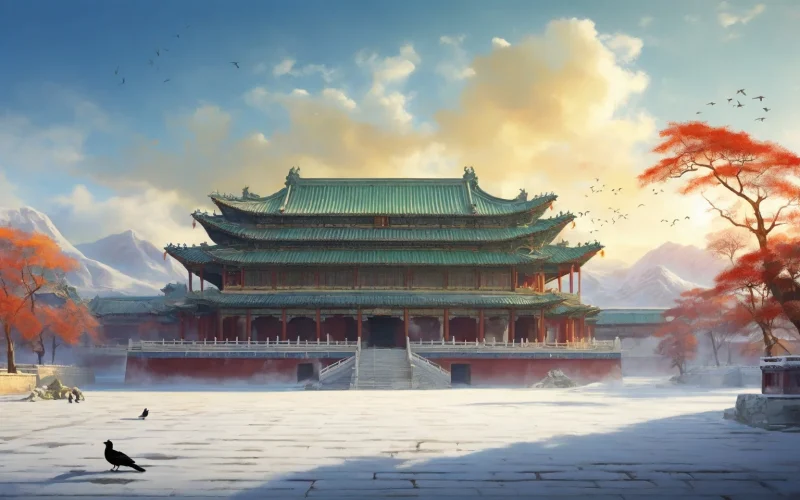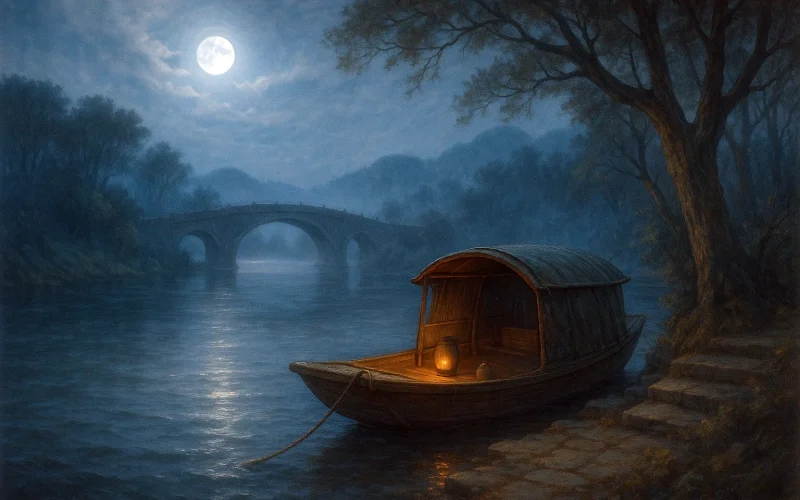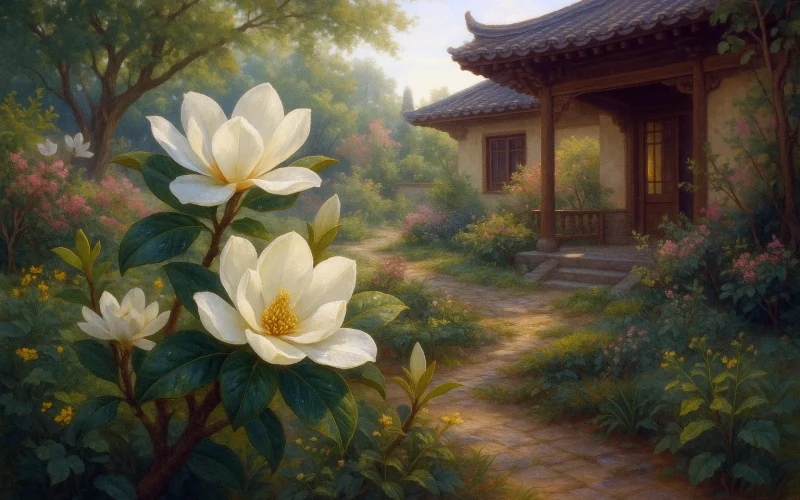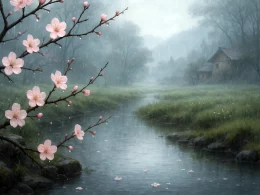Night snow still flies o'er Tianmu Peak's domain,
Dawn's clear light first warms Taiqing's sacred fane.
Clouds roll like peacocks with gold-flowered green,
Sun shoots through mandarin-tile roofs' crimson sheen.
Officials burn incense 'neath willows' shade,
A crow flies east on eaves where light is laid.
I gaze up at nine sages in dragon robes,
"Long live the reign!" they chant to heaven's globes.
Original Poem
「早谒景灵宫」
杨万里
夜雪犹飘天目峰,晓晴先暖太清宫。
云翻孔雀金花碧,日射鸳鸯玉瓦红。
百辟焚香官柳影,一鸦飞立殿檐东。
仰瞻九圣联龙衮,万岁千秋对昊穹。
Interpretation
Jingling Palace, located in Lin'an (present-day Hangzhou, Zhejiang), was a Song Dynasty hall for worshipping past emperors and ancestors, serving as a crucial site for Southern Song court rituals. Yang Wanli, then an official, participated in the early morning winter worship ceremony. Despite political turbulence, the court maintained solemn sacrificial traditions. With fresh and majestic strokes, the poet depicts his observations and emotions during the dawn visit—both praising Jingling Palace and expressing blessings for the nation’s stability and the imperial house’s enduring peace.
First Couplet: "夜雪犹飘天目峰,晓晴先暖太清宫。"
Yè xuě yóu piāo Tiānmù fēng, xiǎo qíng xiān nuǎn Tàiqīng gōng.
Night snow still drifts over Tianmu Peak;
Dawn’s clear skies first warm Taiqing Palace.
The opening contrast between night snow and morning light establishes a unique winter dawn atmosphere: while snow lingers on cold mountain peaks, the palace is already bathed in sunlight. The pairing of Tianmu Mountain and Taiqing Palace not only references Lin’an’s geography but also implies the "imperial residence’s nobility, first to receive heaven’s favor."
Second Couplet: "云翻孔雀金花碧,日射鸳鸯玉瓦红。"
Yún fān kǒngquè jīn huā bì, rì shè yuānyāng yù wǎ hóng.
Clouds churn like peacock feathers, gold flowers emerald;
Sunlight strikes mandarin-duck jade tiles, glowing crimson.
Here, resplendent colors portray the palace’s grandeur. Peacock feathers, gold blossoms, and jade tiles—all precious ornaments—reflect its opulence. The dynamic interplay of churning clouds and radiating light creates a magnificently brilliant scene.
Third Couplet: "百辟焚香官柳影,一鸦飞立殿檐东。"
Bǎi pì fénxiāng guān liǔ yǐng, yī yā fēi lì diàn yán dōng.
Officials burn incense under palace willows’ shadows;
A crow flies and perches east of the hall’s eaves.
This couplet contrasts solemnity with mundanity: while officials reverently burn incense, a crow lands casually on the eaves, adding authenticity. Willow shadows sway with smoke, and the crow accents the scene, infusing solemnity with vitality.
Fourth Couplet: "仰瞻九圣联龙衮,万岁千秋对昊穹。"
Yǎng zhān jiǔ shèng lián lóng gǔn, wànsuì qiānqiū duì hào qióng.
Gazing up at Nine Saints in dragon robes aligned;
"Ten thousand years!" they chant toward the vast heavens.
The conclusion directly expresses worship: officials honor ancestors, pledging eternal stability to the imperial house. "Nine Saints in dragon robes" (九圣联龙衮 jiǔ shèng lián lóng gǔn) symbolize imperial majesty; "ten thousand years" (万岁千秋 wànsuì qiānqiū) conveys blessings; "toward the vast heavens" (对昊穹 duì hào qióng) invokes heaven as witness, elevating emotion to solemn grandeur.
Holistic Appreciation
This regulated verse depicts the solemn scene of a dawn palace visit. The first two couplets contrast natural scenery and palatial splendor: the cold serenity of Tianmu’s night snow versus the warm radiance of Taiqing’s morning light. The progression from mountains to palace, nature to human affairs, unfolds layer by layer. The third couplet shifts from grandeur to detail: officials’ reverence juxtaposed with a crow’s chance arrival, rendering the scene vivid and authentic. The finale clarifies the theme—worshipping ancestors and blessing the imperial house.
The poem deftly intertwines natural views, architectural magnificence, and ritual atmosphere, offering both visually majestic imagery and profound ceremonial solemnity. It reveals the poet’s keen eye for natural beauty and his grasp of courtly grandeur.
Artistic Merits
- Contrasting elements: Night snow vs. morning light, Tianmu Peak vs. Taiqing Palace, incense smoke vs. crow—all enhance dramatic tension.
- Luxuriant colors: "Peacock gold-emerald" and "mandarin-duck jade-crimson" employ dazzling hues, highlighting dignity and grandeur.
- Dynamic-static interplay: Churning clouds, radiating light, swaying smoke, and a perching crow create a vivid tableau where motion and stillness coexist.
- Structural integrity: From distant views to close-ups, nature to human affairs, description to emotion—the structure is tightly woven and progressively layered.
Insights
This poem not only portrays the majestic scene of a dawn palace visit but also demonstrates how literati integrated poetry with state and ritual. It reminds us that poetry transcends personal emotion, serving as a vessel for historical culture. Through the fusion of scene and feeling, it carries national identity and cultural memory. By blending keen observation with court ritual, Yang Wanli creates a grand yet lively tableau, allowing later generations to sense the Southern Song court’s imposing presence.
About the Poet
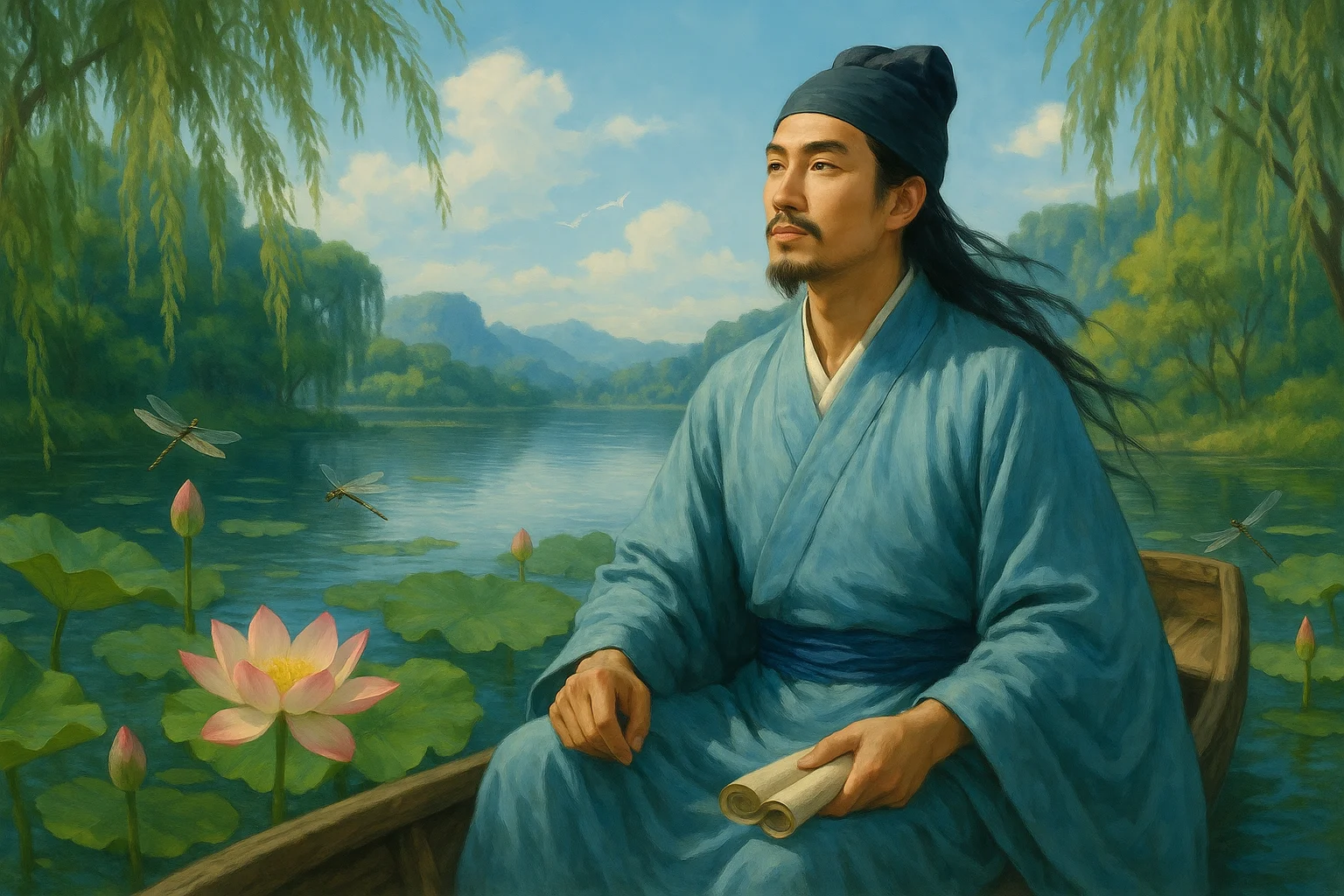
Yang Wanli (杨万里 1127 - 1206), a native of Jishui in Jiangxi, was a renowned poet of the Southern Song Dynasty, celebrated as one of the "Four Great Masters of the Restoration" alongside Lu You, Fan Chengda, and You Mao. He attained the jinshi degree in 1154 and rose to the position of Academician of the Baomo Pavilion. Breaking free from the constraints of the Jiangxi School of Poetry, he pioneered the lively and natural "Chengzhai Style," advocating for learning from nature and employing plain yet profound language. His poetry, often drawing inspiration from everyday life, profoundly influenced later schools of lyrical expression, particularly the Xingling (Spirit and Sensibility) School.






